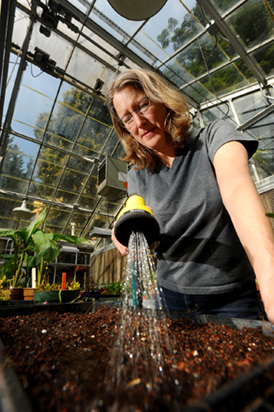
Gretchen LeBuhn's Great Sunflower Project has two goals: Find pollinating bees and provide them with more pollen resources.
She set up the Great Sunflower website and sent out a handful of e-mails to master gardening groups around the U.S. to encourage participation. "Then I went on vacation, tried to log in and couldn?t get into the site," LeBuhn recalls, laughing. "I called my Web design guy and he said, ?Oh Gretchen, we?ve taken the site offline, we think the surge wasn?t spam, but a tide of nearly 15,000 volunteers who signed up within the first month of the project.
"I used to despair about our ability to affect change," LeBuhn says. "This restored hope in me that we as a society can do some things to really improve the world."
The project has grown steadily since, and LeBuhn works with the site?s outreach director Fred Bove to keep on top of the citizen scientists? questions and concerns. In many cases, the participants help run the project by answering others? questions through the site?s forum pages.
Bove says the volunteers are drawn to the project by the prospect of doing good, especially in the face of grim news about climate change and species loss. "Just by sitting down for 15 minutes, they become calmer and more aware of nature." Andrea Wiggins, a doctoral student at Syracuse University studying the role that technology plays in organizing citizen scientist groups, calls the Great Sunflower Project "a pretty entrepreneurial approach to doing scientific research." LeBuhn, she says, has been unusually adroit in reformulating the project as it has expanded and become more expensive. "She has found multiple sources of funding to support the project and is developing partnerships to help expand what people can do." With additional funding, LeBuhn hopes to move beyond collecting data that is useful for science, to "making the data usable by the volunteers and creating guidelines and opportunities for groups to do conservation."
In the U.S., the value of pollination services provided to humans by bees is estimated between $4 and $6 billion per year. But urbanization, climate change and a mysterious syndrome called colony collapse disorder threaten these essential animals and the ecosystems they share with humans, LeBuhn says.
"We want to encourage people to include just one more square foot of new pollinator habitat in their yards," she says, "and really get people to think about how to manage landscapes and the own personal space." When Bove talks about the project with school children, he often "deconstructs" a hamburger for them, showing them how each part of the burger can be connected to healthy bee communities. "We want them be aware of the fact that their food depends on these pollinators."
Honeybees may grab the headlines, but there are 4,000 species of bee in the United States -- about a third of which live in California.
"When we talk about pollination, we?re not just talking about honey bees, we are talking about 3,999 other species that also make these contributions," LeBuhn says. "I?d like to leave people with a sense of wonder that there?s this big group of insects out there working for us."